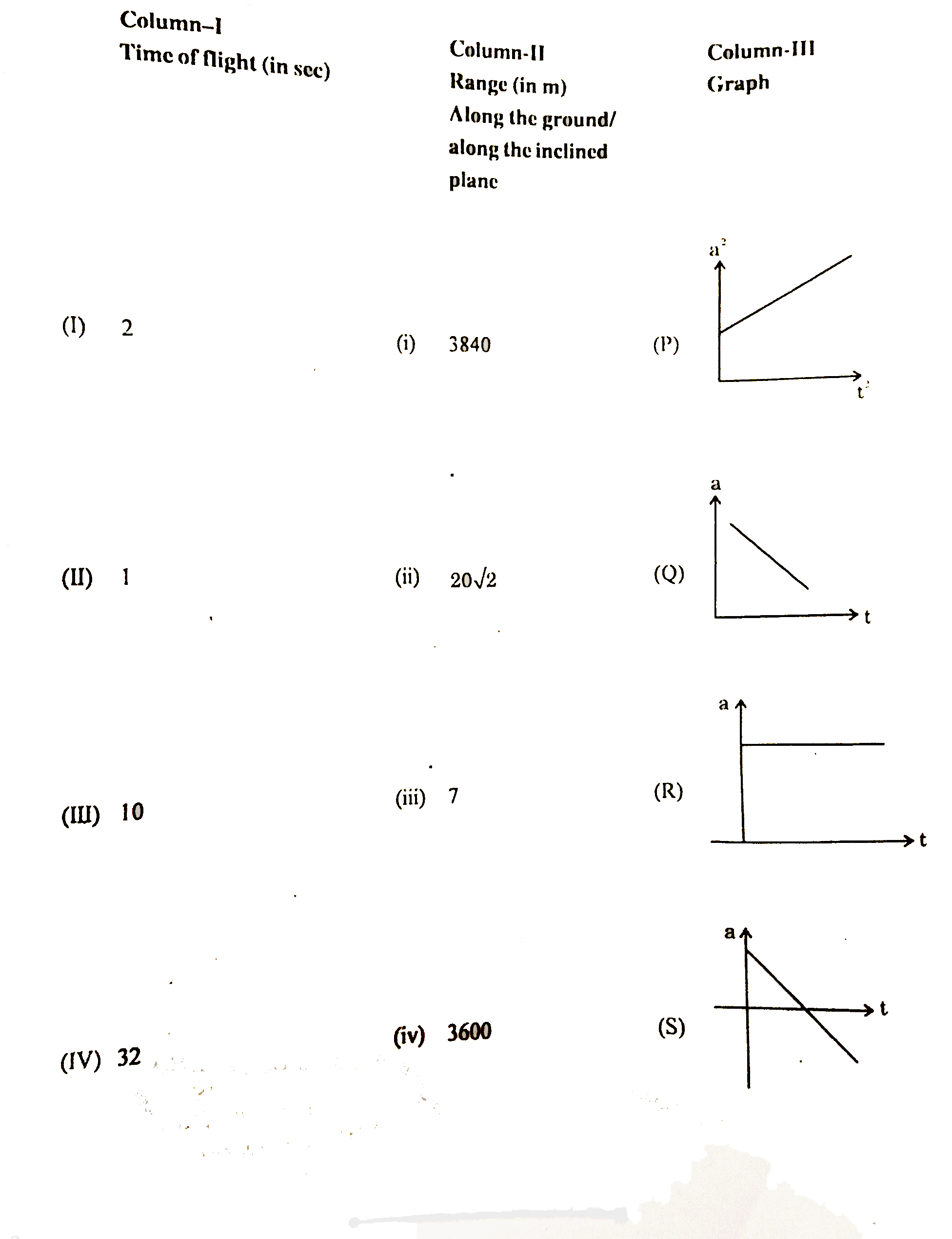A ball is projected horizontally. After 3s from projection its velocity becomes 1.25 times of the velocity of projection. Its velocity of projection is
10 m/s
20 m/s
30 m/s
40 m/s
The correct Answer is:D
To solve the problem, we need to find the velocity of projection of a ball that is projected horizontally. After 3 seconds, its velocity becomes 1.25 times the initial velocity of projection. Let's denote the initial velocity of projection as v.
1. Understand the motion: The ball is projected horizontally, which means its initial vertical velocity (uy) is 0 m/s, and it has a horizontal velocity (vx) equal to v.
2. Determine the vertical velocity after 3 seconds:
The vertical velocity (vy) after time t can be calculated using the equation:
vy=uy+ay⋅t
Here, uy=0, ay=−g (where g≈9.81m/s2), and t=3s:
vy=0−9.81⋅3=−29.43m/s
(We can take the magnitude, so vy=29.43m/s).
3. Find the resultant velocity after 3 seconds:
The resultant velocity (V) after 3 seconds is given to be 1.25 times the initial velocity of projection:
V=1.25v
4. Use the Pythagorean theorem to relate the velocities:
The resultant velocity can be expressed using the horizontal and vertical components:
V=√v2+v2y
Substituting the values we have:
1.25v=√v2+(29.43)2
5. Square both sides to eliminate the square root:
(1.25v)2=v2+(29.43)2
Expanding this gives:
1.5625v2=v2+867.4249
6. Rearranging the equation:
1.5625v2−v2=867.4249
0.5625v2=867.4249
7. Solving for v2:
v2=867.42490.5625≈1540.76
8. Taking the square root to find v:
v=√1540.76≈39.24m/s
9. Final answer:
Rounding to two decimal places, the velocity of projection is approximately 40m/s.
Conclusion:
The velocity of projection is approximately 40m/s.
The vertical velocity (vy) after time t can be calculated using the equation:
vy=uy+ay⋅t
Here, uy=0, ay=−g (where g≈9.81m/s2), and t=3s:
vy=0−9.81⋅3=−29.43m/s
(We can take the magnitude, so vy=29.43m/s).
The resultant velocity (V) after 3 seconds is given to be 1.25 times the initial velocity of projection:
V=1.25v
The resultant velocity can be expressed using the horizontal and vertical components:
V=√v2+v2y
Substituting the values we have:
1.25v=√v2+(29.43)2
(1.25v)2=v2+(29.43)2
Expanding this gives:
1.5625v2=v2+867.4249
1.5625v2−v2=867.4249
0.5625v2=867.4249
v2=867.42490.5625≈1540.76
v=√1540.76≈39.24m/s
Rounding to two decimal places, the velocity of projection is approximately 40m/s.
The velocity of projection is approximately 40m/s.
Topper's Solved these Questions
- KINEMATICS-2DBOOK - ALLENCHAPTER - KINEMATICS-2DEXERCISE - Exercise (O-2)
46 Videos
- KINEMATICS-2DBOOK - ALLENCHAPTER - KINEMATICS-2DEXERCISE - Exercise (S-2)
15 Videos
- GRAVITATIONBOOK - ALLENCHAPTER - GRAVITATIONEXERCISE - EXERCISE 4
9 Videos
- MOTION IN A PALNEBOOK - ALLENCHAPTER - MOTION IN A PALNEEXERCISE - SOLVED EXAMPLE
28 Videos
Similar Questions
A body is projected horizontally from the top of a tower with a velocity of 30 m/s. The velocity of the body 4 seconds after projection is (g = 10ms−2)
View SolutionMatch the following

In groung to ground projection a particle is projected at 53∘ from horizontal. At t=25 sec after projection, its velocity vector becomes perpendicular to its initial velocity vector.
(Given →a=g⏐↓=10m/s2)
View SolutionThe velocity at the maximum height of a projectile is √32 times the initial velocity of projection. The angle of projection is
View SolutionA particle is projected with velocity 20ms−1 at angle 60∘ with horizontal . The radius of curvature of trajectory , at the instant when velocity of projectile become perpendicular to velocity of projection is , (g=10ms−1)
View SolutionA ball is projected from a high tower with speed 20 m/s at an angle 30∘ with horizontal x-axis. The x-coordinate of the ball at the instant when the velocity of the ball becomes perpendicular to the velocity of projection will be (take point of projection as origin):
View SolutionA body is projected horizontally from the top of a tower with a velocity of 20 m/s. After what time the vertical component of velocity is four times the horizontal component of velocity ? (g = 10m/s2)
View SolutionA ball is projected horizontally from the top of a building 19.6 m high. If the line joining the point of projection to the point where it hits the ground makes an angle of 45∘ to the horizontal, the initial velocity of the ball is
View SolutionA ball is projected from ground in such a way that after 10 seconds of projection it lands on ground 500 m away from the point of projection. Find out :-
(i) angle of projection
(ii) velocity of projection
(iii) Velocity of ball after 5 seconds
View SolutionA stone is projected horizontally with a velocity 9.8ms−1 from a tower of height 100 m. Its velocity one second after projection is (g=9.8ms−2).
View SolutionThe velocity at the maximum height of a projectile is half of its initial velocity of projection. The angle of projection is
View Solution
